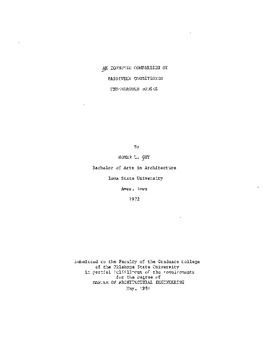| dc.contributor.advisor | Boyer, Lester L. | |
| dc.contributor.author | Guy, Roher L. | |
| dc.date.accessioned | 2015-08-27T16:44:01Z | |
| dc.date.available | 2015-08-27T16:44:01Z | |
| dc.date.issued | 1981-05-01 | |
| dc.identifier.uri | https://hdl.handle.net/11244/16746 | |
| dc.description.abstract | This study is concerned with the analysis of underground housing alternatives that strive for minimum expenditure of energy for space conditioning. The two alternatives that are compared to the conventional "base" underground house introduce the theoretical principles of soil mixing and introduce a new method of predicting underground house cooling costs. This study also introduces a method of maximizing the flow of heat collected during the summer into the soil for winter space conditioning and conversely the rejection of heat during the winter for low soil temperatures during the summer. The end product is radiant conditioning of the underground alternative through lower than steady state soil temperatures in the summer and higher soil temperatures in the winter. | |
| dc.format | application/pdf | |
| dc.language | en_US | |
| dc.publisher | Oklahoma State University | |
| dc.rights | Copyright is held by the author who has granted the Oklahoma State University Library the non-exclusive right to share this material in its institutional repository. Contact Digital Library Services at lib-dls@okstate.edu or 405-744-9161 for the permission policy on the use, reproduction or distribution of this material. | |
| dc.title | Economic Comparison of Passively Conditioned Underground Houses | |
| dc.type | text | |
| dc.contributor.committeeMember | Grondzik, Walter T. | |
| dc.contributor.committeeMember | Chamberlain, W. George | |
| osu.filename | Thesis-1981-G986e.pdf | |
| osu.accesstype | Open Access | |
| dc.description.department | Architectural Engineering | |
| dc.type.genre | Thesis | |
